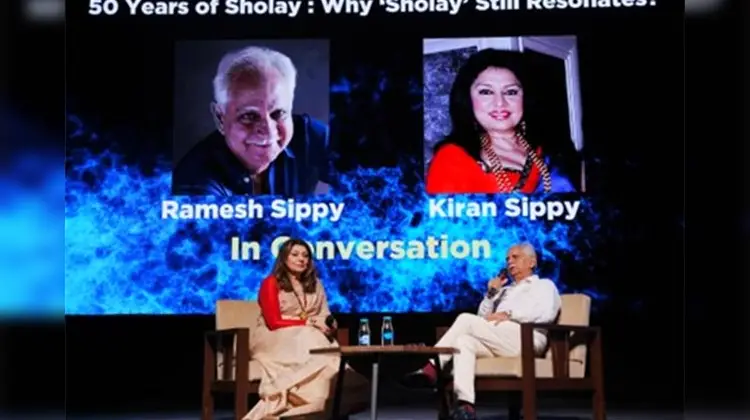Filmmaker Ramesh Sippy, the creator of the iconic Hindi film ‘Sholay’, captivated audiences at the 56th International Film Festival of India (IFFI) with a nostalgic ‘In-Conversation’ session that celebrated the film’s 50-year legacy. The biggest revelation of the event was Sippy’s announcement: the movie will be re-released with its original, intended ending intact, which had been censored during the 1975 release.
The session, titled “50 Years of Sholay: Why Sholay Still Resonates?”, was hosted by Sippy’s wife, actor-producer Kiran Sippy, and offered cinematic revelations about the making of the cultural milestone.
Sippy revealed that when ‘Sholay’ was first released during the Emergency period in 1975, the Central Board of Film Certification (CBFC) objected to the climax where Thakur Baldev Singh (Sanjeev Kumar) kills Gabbar Singh (Amjad Khan), arguing that a police officer could not be portrayed seeking revenge. The team was forced to reshoot the ending.
An elated Sippy told the audience, “Now you will see the movie as it was made,” celebrating the long-overdue restoration of his creative vision.
The director shared several key insights into the film’s unconventional production and casting:
- Visual Palette: Sippy deliberately sought a new visual palette, scouting rugged terrain near Mysuru and Bengaluru in South India for the backdrop. This rocky setting provided a distinctive look, departing from the typical dacoit dramas shot in Rajasthan.
- The Birth of Gabbar: The character of Gabbar Singh was born when Sippy told writer duo Salim-Javed he wanted a villain who was unpredictably dangerous. Danny Denzongpa was the original choice for the role but was unavailable due to overseas commitments. Amjad Khan, recommended by Salim-Javed, was selected after impressing Sippy with his theatrical prowess.
- Teamwork and Technical Firsts: ‘Sholay’ was a product of extraordinary teamwork. It was the first Indian film to bring in a professional fight sequence team from the United Kingdom, pioneering safety protocols for action scenes in Hindi cinema.
- Cinematic Magic: Sippy recalled the dedication of the team, noting that cinematographer Dwarka Divecha set new benchmarks, and the evocative lighting of Jaya Bhaduri’s evening lamp sequence took days to capture, waiting for the perfect “magic hour.”
Sippy grew emotional reflecting on the film’s towering actors who have since passed away, paying heartfelt tribute to Sanjeev Kumar, Amjad Khan, and Dharmendra (who passed away recently), recalling Dharmendra’s dedication during a risky horse-riding sequence.
As the session concluded, it was clear that ‘Sholay’ is not merely a film but a living legacy. With its 50-year celebration and the return of its original ending, it is ready to roar once again, exactly as its maker envisioned it half a century ago.
Key Highlights:
- Filmmaker Ramesh Sippy headlined an ‘In-Conversation’ session at IFFI 2025 celebrating 50 years of ‘Sholay’, where he made the long-awaited announcement of the film’s re-release with its original, uncensored ending.
- The original climax, where Thakur Baldev Singh kills Gabbar Singh, was censored in 1975 during the Emergency because the CBFC objected to a police officer seeking revenge.
- Sippy revealed that the film’s distinctive look was achieved by scouting rugged terrain near Mysuru and Bengaluru, and he shared the anecdote of casting Amjad Khan after original choice Danny Denzongpa was unavailable.
- The director emphasized that ‘Sholay’ was a product of extraordinary teamwork, being the first Indian film to bring in a professional UK fight sequence team and pioneering safety protocols.

